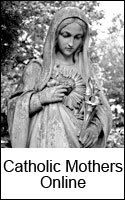
The book I bought at the homeschool conference, Catholic and Loving It, has a list of the final resting places of the 12 apostles (p. 58). I have been to a few of these places, so this kind of interested me and I thought I'd blog about it.
St. John has always been my favorite. When I was pregnant with my son, I "named" his Guardian Angel, John, because John was the beloved apostle, full of charity and compassion, and I knew he would look after my son during a very rough pregnancy. After all, Jesus trusted John enough to look after His own mother.
What is now the countryside, just a few miles from Ephesus, are the remains of the Basilica of St. John (St. Jean Aniti). The bascilica, shown below in a recreation of what the church looked like, was constructed by Emperor Justinian in the 6th century. It stood over the believed burial site of St. John. St. John lived a long life, with reports placing him around 96-100 years old.

The basilica stood on the slopes of Ayasoluk Hill near the center of Selçuk, just below an ancient fortress. St. John's basilica was cruciform and roofed with six massive domes. The capitals facing the nave (central aisle, surrounding the tomb) bear the monograms of the Emperor Justinian and his wife Theodora.
Legend maintains that St. John wrote his gospel in Ephesus, then died on Ayasoluk Hill. Later legends developed that he was not really dead, but sleeping, and dust could even be seen moving above his grave as he breathed.
The traditional tomb of St. John is raised by two steps and covered with marble. The tomb was under the central dome, in the transcept.

The current entrance leads into the basilica through the southern transept. Originally, entry was through the oversize exterior courtyard atrium to the west of the nave, which led worshipers through the narthex and finally into the far end of the nave.
The brick foundations and marble walls have been partially reconstructed; if they were fully restored, the cathedral would be the seventh largest in the world. Recently, excavations east of the apse have revealed a key-hole shaped baptistery and central pool, along with an attached chapel covered in frescoes depicting the saints. Rampart walls around the church were constructed for protection from the Arabian attacks in the 7th - 8th centuries AD.

The bascilica's construction of stone and brick was very uncommon for architecture during this time. Sadly, however, with the decline in importance of Ephesus and after Arab raids, the basilica fell into ruins until the Seljuk Aydinoglu clan converted it into a mosque in 1330. The building was then completely destroyed in 1402 by Tamerlane's Mongol army. The ruined church was later pillaged for building materials, but recent restoration enables visitors to understand its size and visualize its former splendor.
The remains of St. John and the bascilica lie in the picturesque and bucolic Turkish countryside, very peaceful and serene.



















No comments:
Post a Comment